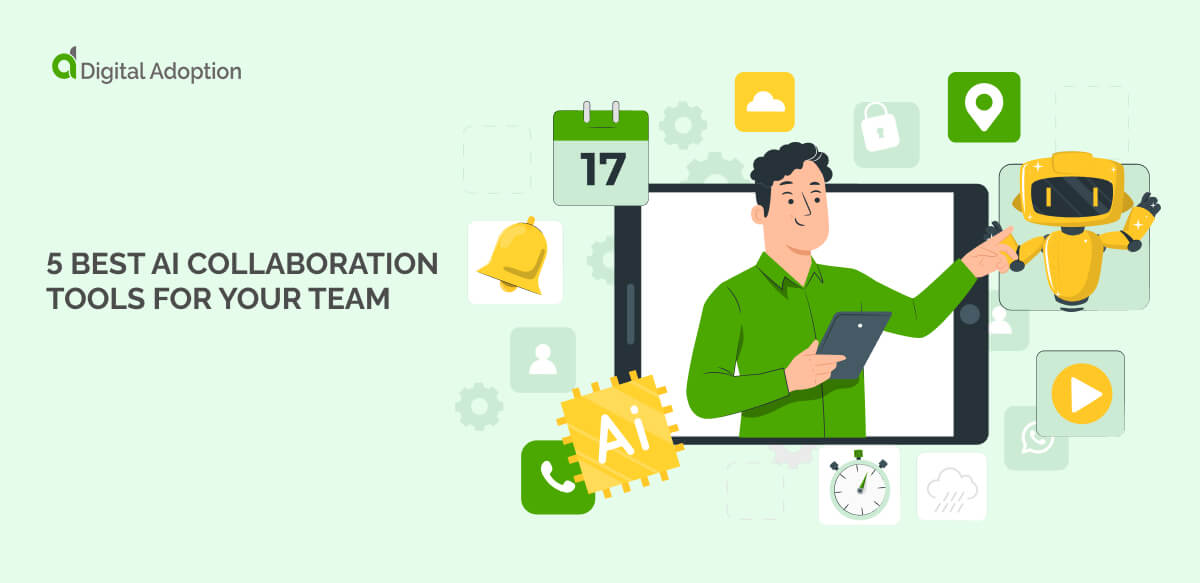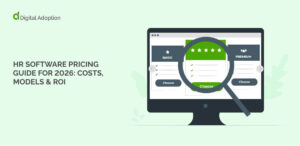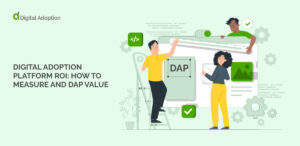AI collaboration tools are software platforms that use artificial intelligence (AI) to enhance teamwork and productivity.
These tools use AI capabilities, such as natural language processing (NLP) and machine learning (ML), to streamline team communication and automate tasks.
This article explores the top five AI collaboration tools on the market today. This list is tailored for business leaders, team managers, and professionals looking to optimize their digital workflow.
We’ll explore each tool’s key features, integrations, security measures, and pricing options.
The tools were selected based on their AI capabilities, user ratings, and ability to address different collaboration needs across various industries.
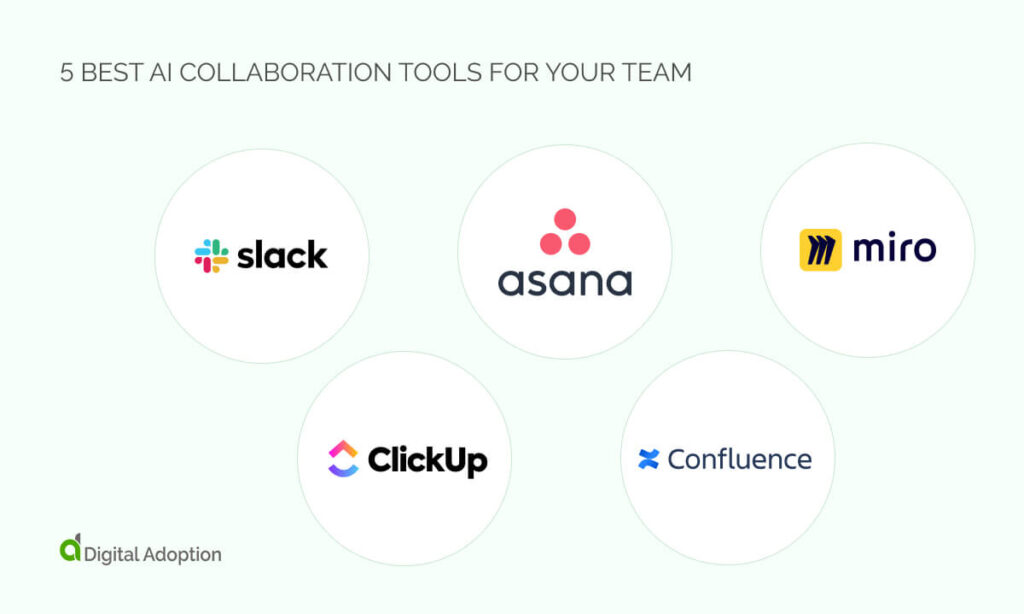
- Best tool for communication and messaging
- Best tool for task management and project planning
- Best tool for talent management and time tracking
- Best tool for document collaboration and knowledge management
- Best tool for visual collaboration and brainstorming
- AI collaboration tools: The future of teamwork
- People Also Ask
Best tool for communication and messaging
Effective communication and collaboration are crucial for keeping businesses running smoothly. Teams need to share critical information and transfer data in real-time. Without this, organizations can become stagnant, causing operations to fall behind.
Successful businesses rely on unified communication and messaging tools to collaborate effectively. AI has given these tools a new level of performance previously inaccessible.
Slack
- G2 rating: 4.5/5 (33,433 Reviews)
Slack is an all-in-one communication tool trusted by over 10 million daily active users. It is primarily a real-time messaging platform that provides a single resource for enhancing team collaboration.
Their IM tool helps employees securely interact and communicate with one another, no matter where they are in the world. This increases transparency and productivity across teams and helps to deliver business alignment.
Slack’s friendly UI allows users to navigate the platform’s features simply and easily. Its cross-platform compatibility means it can be accessed from web, desktop, and mobile platforms.
Its suite of services offers more than real-time instant messaging. It also provides advanced search and archiving functions, document and data sharing, and more. This makes it a valuable knowledge base employees can use for deriving insights and record-keeping.
For example, employees can utilize Slack’s built-in AI to search for past conversations and historical files. Slack AI summarises conversations and threads that help employees hone in on specific data, documents, past discussions, and much more.
Key AI features
Here’s an overview of the top AI features Slack offers:
- AI-powered search for personalized responses by searching Slack data
- Channel recaps for quick highlights of key information from accessible channels
- One-click thread summaries for easy conversation thread insights
- Daily recaps for customized summaries of unread channels and selected topics
- Huddle summaries for automatic extraction of key details and action items from Slack meetings
- AI-powered Agentforce agents for tasks like accessing sales data and generating emails
- Third-party AI agent support for integrations with AI platforms like Cohere and Adobe
- Custom AI agent development using Slack’s APIs
- AI Workflow Builder for automating tasks from natural language prompts
- Integration with Einstein Copilot for CRM-related queries and actions in Slack
- Expanded data source access for search and summaries, including documents and files
Integrations
Here are some key integrations for Slack:
- Google Drive: Create and share files, get updates on changes
- Trello: Manage cards and receive project updates in Slack
- Zoom: Start or join meetings with one click, get notifications
- Asana: Create tasks and get project updates in Slack
- Jira Server: Create and track issues with real-time updates
- GitHub: Get notifications for commits, pull requests, and issues
- Salesforce: View records and get updates on leads and deals
Security and privacy
Let’s examine the steps Slack has taken to uphold strong security and privacy standards:
- Identity management: Uses Single Sign-On (SSO), domain claiming, and enterprise mobility
- Access control: Limits access to authorized users and devices
- Data protection: Offers encryption, key management, audits, and Data Prevention Loss (DLP)
- Information governance: Provides retention, legal hold, and e-discovery
- Risk management: Enables flexible governance and risk management
Pricing
| Plan | Price | Billing |
| Free | $0.00 | N/A |
| Standard | $6.67 | Monthly |
| Business+ Plan | $12.50 pp/per month | Monthly |
| Enterprise Grid | Contact Slack | |
Best tool for task management and project planning
The logistics of managing tasks and preparing to launch projects require a meticulous eye for detail. A few pre-requirements determine how well a project or task is performed and whether it’s delivered on time.
These include defining the project scope and objectives, creating detailed work breakdown structures, and establishing realistic timelines.
Asana
- G2 rating: 4.4/5 (10,456 Reviews)
Asana is a web-based collaboration tool that helps teams optimize task and project management objectives. It can execute projects, organize tasks, exchange data, and share documents.
This work management solution has a clean UI that allows teams to visualize projects as collections of colour-coded units. Unit specs can be customized to accommodate the needs of top-level management or teams. These units serve as building blocks for effective project management and development.
The platform’s intuitive UI offers multiple project views. These include List, Kanban board, Calendar, Timeline, and a personalized My Tasks view for individual task management. Projects can also be filtered by criteria such as name, priority, or specific keywords.
Asana enables managers to set goals and milestones using its project management and reporting tools. Managers can view the status of active projects from the Dashboard and send messages, update reminders, and make announcements.
AI teammates enter the chat to enhance Asana’s product offerings. It can help augment decision-making and take over mundane tasks through digital process automation.
Project leads can use AI teammates to deploy AI-generated summaries and updates and spot potential risks and roadblocks with real-time insights. They can also structure workflows and improve communication tactics with auto-reply suggestions.
Key AI features
Here’s an overview of the top features Asana offers:
- AI teammates for task automation, workflow orchestration, and answering project-related questions
- Smart Fields and Projects for auto-generated custom fields and project setups
- Smart Editor for drafting and improving task descriptions, comments, and content
- Smart Summaries for surfacing highlights and key action items from task details
- Smart Status for comprehensive status updates by analyzing real-time work data
- Smart Answers for project insights via natural language questions
- Smart Goals for writing effective goals based on past performance and data
- Smart Workflows for creating workflows using natural language instructions
- Smart Digests for rundowns of recent project activity and next steps
- Smart Search for natural language searches across Asana’s data
- Smart Reporting for charts and visualizations generated from natural language requests
- Smart Onboarding for suggesting relevant projects and goals for new team members
- Smart Workload for monitoring and adjusting team resourcing based on capacity
Integrations
Here are some key integrations for Asana:
- Google Workspace: Attach Google files to Asana tasks
- Microsoft Teams: Get Asana updates in Teams channels
- Zoom: Schedule meetings from Asana for task discussions
- Jira: Sync Asana tasks with Jira issues for streamlined workflows
- Dropbox: Link files to Asana tasks for easy document access
Security and privacy
Let’s take a look at the measures taken by Asana to maintain a healthy security and privacy posture:
- Strong authentication: Supports Security Assertion Markup Language (SAML), Google Single Sign-On (SSO), and Two-Factor Authentication (2FA)
- User management: Controls access and limits external collaboration
- Access control: Allows custom user permissions across teams
- Data compliance: Uses global data centers and follows Health Insurance Portability and Accountability Act (HIPAA) rules
- Advanced security: Employs audit logs, Data Loss Prevention (DLP), and Security Information and Event Management (SIEM) for protection
Pricing
| Plan | Price | Billing |
| Personal | $0.00 (10 users) | N/A |
| Starter | $10.99 per month (500 seats) | Monthly |
| Advanced | $24.99 per month (500 seats) | Monthly |
| Enterprise | Contact Asana | |
Best tool for talent management and time tracking
Employees are the lifeblood of any business. As such, efficient talent management is needed to help maintain employee performance and productivity.
AI is making it possible to better manage employees and track productivity. Several products currently on the market use state-of-the-art features for managing small teams and enterprise firms.
ClickUp
- G2 rating: 4.7/5 (9,883 Reviews)
ClickUp steps in as a top contender, with ClickUp Brain serving as its core AI offering. With time tracking available from any device, time estimates, and in-depth reporting, tracking, and measuring progress becomes easy.
The Everything View shows all tasks across the workspace, giving teams a birds-eye view of all ongoing work.
The platform’s organizational system consists of Spaces, Folders, and Lists, creating a structured hierarchy. This structure makes it easy to manage teams and complex projects.
Customizable tasks let users adjust fields, statuses, and priorities to match their workflow, while nested subtasks and checklists allow for breaking down project objectives into more manageable subtasks.
ClickUp’s time tracking feature lets teams easily log hours, and time estimates help plan resources. Its detailed reporting tools provide clear insights into project timelines, task completion, and time spent, ensuring projects stay on track and performance is measurable.
Key AI features
ClickUp Brain offers a variety of new AI features, here’s an overview:
- Interactive Q&A for instant, context-aware answers within the workspace
- AI-generated contextual answers specific to tasks or documents
- One-click task and document summaries for quick overviews
- AI writing assistant for faster, contextual suggestions
- 100+ customized prompts and templates for different roles like marketing and engineering
- Smart workflow creation using natural language for intuitive automation
- AI automation builder for generating processes based on user instructions
- AI writing for content generation in tasks, documents, and emails
- Context-aware email drafting for quick email creation
- AI-powered content editing and improvement suggestions
- AI-generated subtasks from task descriptions for streamlined task management
- Personalized AI standups based on work progress
- AI custom fields for task summaries and updates without opening tasks
- AI-powered search for quick answers from ClickUp data
- Document generation for product requirements and technical specifications
- Voice clip transcription for automatic voice-to-text conversion
- AI translator for improved cross-language communication
Integrations
Here are some key integrations for ClickUp:
- Zapier: Connect ClickUp with apps for custom workflows
- Tableau: Create visualizations from ClickUp data
- Intercom: Generate tasks from customer interactions
- Jira: Sync projects and tasks for team collaboration
- GitLab: Link code commits to ClickUp tasks for traceability
Security and privacy
Here’s a summary of the measures taken by ClickUp to maintain an effective security and privacy posture:
- Data security: Prioritizes client data protection and user experience
- Secure hosting: Uses AWS with advanced security features and certifications
- Infrastructure: Operates in a secure environment with restricted access
- Compliance: Maintains SOC 2 compliance and ISO certifications
- Encryption: Employs TLS 1.2 for communications and AES 256 for data at rest
Pricing
| Plan | Price | Billing |
| Free | $0.00 | N/A |
| Unlimited | $7.00 | Monthly |
| Business | $12.00 | Monthly |
| Business Plus | $19.00/per user | Monthly |
Best tool for document collaboration and knowledge management
Document collaboration and knowledge management tools help teams work together on files and share information easily.
These tools let people edit documents at the same time, track changes, and keep everything organized. They also store important company knowledge, making it easy for team members to find and use information when needed.
Confluence
- G2 rating: 4.1/5 (3,767 Reviews)
The penultimate entry in the list, Confluence, uses AI to enhance document collaboration and knowledge management. This platform is a central hub for teams to create, organize, and share information effortlessly.
Confluence is a digital workspace where teams can collaboratively draft, edit, and refine documents in real-time. The platform’s interface allows users to create structured pages, making building wikis, project plans, and company intranets easy.
Confluence’s AI capabilities significantly enhance the user experience. The platform employs machine learning algorithms to suggest relevant content, improving information discovery and reducing time spent searching for documents. Its smart search function understands context and user intent and delivers more accurate results.
The AI-driven features extend to content creation as well. Confluence also offers intelligent writing assistance. It provides suggestions for clearer and more concise language and automatically generates summaries of long documents.
Key AI features
Here’s an overview of the top AI features Confluence offers:
- AI-powered writing assistance for drafting, improving writing, and adjusting tone
- Smart Editor for generating content for strategy pages and project overviews
- Ability to simplify technical information for cross-team communication
- Quick summaries of Confluence pages, blogs, and comments
- AI-powered summaries panel for automatic page content summarization
- Smart Link summaries for linked content without leaving the current page
- Q&A search for natural language questions and instant answers from Confluence content
- Semantic search for more accurate results
- AI-generated definitions for company-specific terms, acronyms, and project names
- AI panel that identifies and lists action items from pages
- Natural language automation for creating rules from simple instructions
- AI-powered automation templates and components
- Integration with Knowledge Source for context-aware responses
- Support for various file types, including Office docs, PDFs, and text files
- AI-assisted conversations within Confluence through Chat with Confluence
- Intelligent Query for contextual answers specific to tasks or documents
Integrations
Here are some key integrations for Confluence:
- Jira: Sync issues for seamless workflow management
- Trello: Embed boards in Confluence for task visualization
- Slack: Share content and updates in Slack channels
- Microsoft Teams: Access Confluence pages within Teams
- Google Workspace: Integrate Google files into Confluence pages
Security and privacy
Here’s a summary of the measures taken by Confluence to maintain an effective security and privacy posture:
- Data isolation: Separates customer data for privacy
- Threat detection: Uses AI to identify and mitigate security risks
- Access management: Offers detailed controls and SSO integration
- Disaster recovery: Ensures data availability with backups and failovers
- Third-party audits: Undergoes regular independent security assessments
Pricing
| Plan | Price | Billing |
| Team Collaboration | $10 | Monthly |
| Team Collaboration + Calendars | $20 | Monthly |
| Team Collaboration + Q&A | $20 | Monthly |
| All-In | $30 | Monthly |
Best tool for visual collaboration and brainstorming
Visual collaboration and brainstorming tools use AI to help teams share ideas. These tools let people draw, add notes, and make online mind maps.
AI can suggest ideas, organize information, and even create simple drawings. This makes it easier for teams to work together and develop new thoughts. These tools make meetings more fun and help people be more creative.
Miro
- G2 rating: 4.7/5 (6,505 Reviews)
Miro is a popular online whiteboard tool that uses AI to make teamwork easier and more resourceful. It’s a digital canvas where people can work together remotely using interactive elements to brainstorm, plan, and visualize ideas.
Teams use Miro to draw, plan, and share ideas. The AI in Miro suggests layouts for your work, making it easier to understand. When you start drawing, the AI can guess what you’re trying to make and help you illustrate it better.
Miro’s AI is also good at organizing information. If you have lots of sticky notes with ideas, the AI can group them into themes. This saves time and helps teams see patterns in their thoughts.
During online meetings, Miro’s AI can take notes and make summaries. This means everyone can focus on talking and thinking rather than writing everything down.
The tool also learns from your use, remembers the diagrams or layouts you like, and suggests them next time. This makes your work faster and more consistent.
Key AI features
Here’s an overview of the top AI features Miro offers:
- AI-powered clustering for automatic grouping of sticky notes by sentiment or keywords
- AI content generation for creating documents, diagrams, and images based on user input
- AI shortcuts for transforming board content into product briefs, research reports, and summaries
- AI sidekicks for instant guidance from roles like Agile coach or product leader
- Smart Editor for generating drafts of task descriptions, comments, and content
- AI summarization for quick overviews of Confluence pages, blogs, and comments
- Intelligent search for natural language queries with instant answers based on Miro content
- AI image generation from text input for visual content creation
- AI diagramming for generating sequence diagrams and visual representations from prompts
- Language processing for interpreting and responding to user commands and queries
- Auto-structuring for converting freeform thoughts into structured workflows or mind maps
- Smart suggestions for intelligent recommendations based on user interactions and patterns
Integrations
Here are some key integrations for Miro:
- Slack: Share boards and get updates in Slack channels
- Microsoft Teams: Use Miro boards in Teams meetings
- Jira: Link boards to Jira issues for visual management
- Zoom: Present Miro boards during Zoom calls
- Google Drive: Import/export files between Miro and Drive
Security and privacy
Here’s a summary of the measures taken by Miro to maintain an effective security and privacy posture:
- Data encryption: Uses TLS 1.2 for data in transit and AES 256-bit for data at rest
- Access control: Provides granular permissions and supports SSO
- Compliance: Adheres to GDPR, CCPA, and SOC 2 Type II standards
- Regular audits: Conducts third-party security assessments and penetration testing
- Data residency: Offers options for data storage in specific geographic regions
Pricing
| Plan | Price | Billing |
| Free | $0.00 | Monthly |
| Starter | $8.00 | Monthly |
| Business | $16.00 | Monthly |
| Enterprise | Contact Miro | |
AI collaboration tools: The future of teamwork
AI collaboration tools are revolutionizing productivity and workplace wellness.
The platforms mentioned in this article streamline communication, automate routine tasks, and provide data-driven insights.
AI tools drive efficiency and competitive advantage by enhancing decision-making and bolstering creativity.
As remote and hybrid work models become prevalent, AI collaboration tools help maintain swift operations and team cohesion. They facilitate real-time collaboration and knowledge sharing across dispersed teams.
Businesses that embrace these AI-driven solutions position themselves for increased agility, improved performance, and sustained growth.
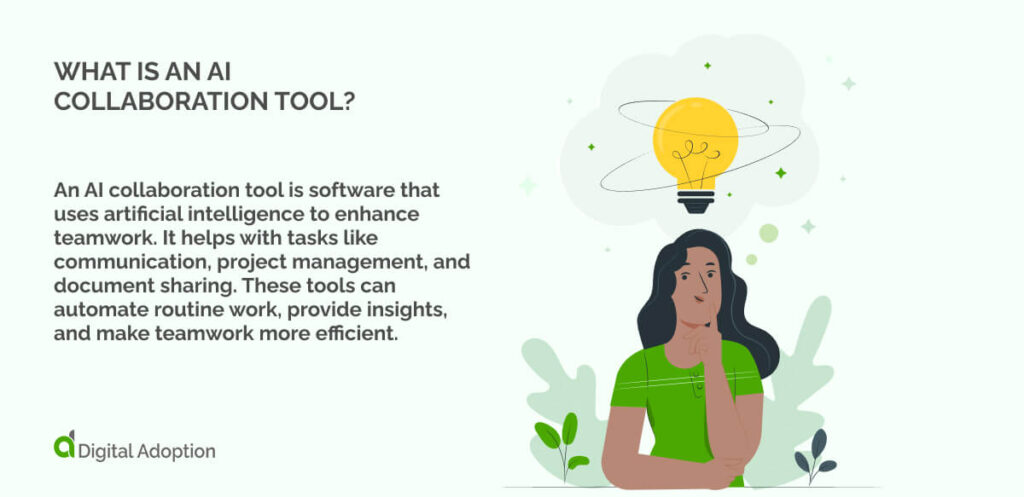
People Also Ask
-
What is an AI collaboration tool?An AI collaboration tool is software that uses artificial intelligence to enhance teamwork. It helps with tasks like communication, project management, and document sharing. These tools can automate routine work, provide insights, and make teamwork more efficient.
-
How do AI collaboration tools improve teamwork?AI collaboration tools improve teamwork by automating repetitive tasks, providing smart suggestions, and organizing information. They help teams communicate better, manage projects more efficiently, and make decisions faster. These tools also make it easier for remote teams to work together effectively.
-
What industries benefit the most from AI collaboration tools?AI collaboration tools benefit many industries but are especially useful in tech, marketing, finance, and healthcare. These industries often deal with complex projects, large amounts of data, and the need for quick decision-making. AI tools help them work more efficiently and innovatively.

 FACT CHECKED
FACT CHECKED